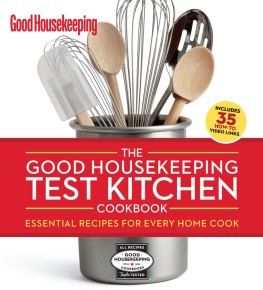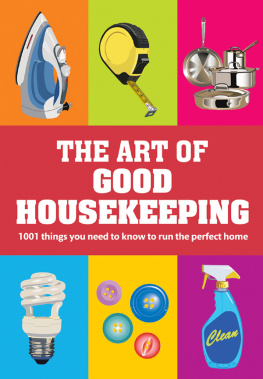 Contents Chapter One
Contents Chapter One
Laundry Lowdown Chapter Two
First Aid for Stains Chapter Three
The A-to-Z Stain-Removal Guide Chapter Four
Keeping Stains at Bay Chapter Five
TLC for Heirloom Textiles L ife can be messyliterally! Whether youre throwing a party, playing in your backyard, painting your bedroom, working on your car, or simply enjoying a family dinner at home, chances are that youll end up with a stain. And it doesnt matter if that stain is on your clothes, your upholstery, or your carpet: You need to know how to get it out. This guide provides immediate, easy-to-follow answers to all your stain questions. Not sure how to get out the catsup that ended up on your shirt after your annual family picnic? What about the grease that got tracked onto your carpet? Or the crayon that mysteriously now decorates your living room couch? Youll discover how to remove these and hundreds of other stains quickly and easily from fabrics, carpet, and upholstery in the books handy A-to-Z Stain-Removal Guide (). Youll also discover surprising and important information on the best ways to use bleach, which stain-removal tools and products you should have on hand, how to identify mystery stains, the best ways to prevent stains, how to treat and store heirloom textiles, and much more. You can even find how to remove the top ten kid stains! (If you are unsure about the cleaning requirements for your fabric, carpet, or upholstery, be sure to test your stain-removal method on a hidden spot.
If you see any evidence of damagesuch as loss of color or a change in textureor if you are unsure about the methods safety for your fabric, consult a professional dry cleaner or a professional upholstery or carpet cleaner for advice.) All this invaluable stain-removal advice comes straight from the cleaning experts at the Good Housekeeping Research Institute. For more than 100 years, the Good Housekeeping Research Institute has evaluated household products, offered helpful advice, and championed the rights of consumers. It is also the driving force behind the Good Housekeeping Seal, the trusted icon awarded to products that are backed by a limited warranty from the Good Housekeeping Research Institute. With this book at your side, you have all the help you need to remove even the trickiest stains. Use it whenever lifeor a messy toddlertosses a stain your way. The Good Housekeeping Research Institute W hy, you ask, would a book about stain removal begin with a chapter on laundry techniques? The answer is simple: Doing your laundry the wrong way can permanently set existing stainsand even create a few new ones.
Doing it the right way means that many stains will disappear with minimal effort. The Laundry Basics Having the right products on hand makes everything easier! DETERGENT Because they perform better in both hard and soft water, detergents have essentially replaced oldfashioned laundry soap for laundering. They are available in liquid or granule forms, with or without additives such as oxygen bleach and fabric softener, and in formulas designed for specific uses, such as cold-water wash or high efficiency for low-sudsing front- or top-loading water-saving washing machines.  PREWASH STAIN & SOIL REMOVERS Pretreatment products are available in many forms: aerosols, pump sprays, sticks, foams, gels, and liquids. Choose the most convenient one for you and use it as recommended for your kind of fabric and type of stain.
PREWASH STAIN & SOIL REMOVERS Pretreatment products are available in many forms: aerosols, pump sprays, sticks, foams, gels, and liquids. Choose the most convenient one for you and use it as recommended for your kind of fabric and type of stain.  BLEACH There are two types: chlorine and nonchlorine (or oxygen) bleach.
BLEACH There are two types: chlorine and nonchlorine (or oxygen) bleach.  BLEACH There are two types: chlorine and nonchlorine (or oxygen) bleach.
BLEACH There are two types: chlorine and nonchlorine (or oxygen) bleach.
The garments care label will tell you which one is safe for your particular item or if you should avoid bleach altogether. Some trims, buttons, and elastics may not react well to bleach. So while bleach might be safe for the fabric, it may not be safe for the whole item. Follow care instructions for best results.  Chlorine Bleach Helps remove stains but can also strip away the color and/or damage certain fibers. It also acts as a disinfectant on bacteria and viruses, which is why it is so useful for items like cloth diapers and baby bibs.
Chlorine Bleach Helps remove stains but can also strip away the color and/or damage certain fibers. It also acts as a disinfectant on bacteria and viruses, which is why it is so useful for items like cloth diapers and baby bibs.
Chlorine bleach works faster and is more effective in restoring whiteness than oxygen bleach, but it can weaken fibers if not used correctly. Chlorine bleach is not safe for silk, wool, mohair, leather, or spandex. Nonchlorine or Oxygen Bleach Helps clean and brighten dingy items. Although it is often called all-fabric bleach, it may damage silk, wool, acetate, and some flame-retardant fabrics. Check the care label.  FABRIC SOFTENER This product makes clothes and household items feel soft and fluffy; it also decreases static cling.
FABRIC SOFTENER This product makes clothes and household items feel soft and fluffy; it also decreases static cling.  FABRIC SOFTENER This product makes clothes and household items feel soft and fluffy; it also decreases static cling.
FABRIC SOFTENER This product makes clothes and household items feel soft and fluffy; it also decreases static cling.
In addition, permanent-press fabrics treated with softener tend to dry faster and wrinkle less. However, it reduces the effectiveness of flame-retardant finishes on childrens sleepwear and can inhibit the moisture-management characteristics of high-performance fabrics used in active sportswear. Towels treated with too much fabric softener become less absorbent. In liquid form, fabric softener is added to the wash during the final stages of the rinse cycle. It is also available as packets or sheets that go into the dryer or as an additive in some laundry detergents.  Sort Smart So youve dragged those soiled and dirty clothes over to the washing machine.
Sort Smart So youve dragged those soiled and dirty clothes over to the washing machine.  Sort Smart So youve dragged those soiled and dirty clothes over to the washing machine.
Sort Smart So youve dragged those soiled and dirty clothes over to the washing machine.
Now what? The first step is to sort them into appropriate wash loads. Eventually, all laundry has to be sorted by: Color (whites and/or lights, darks) Recommended water temperature (cold, warm, or hot) Type of wash cycle (regular or cottons, permanent press or casual, delicate, hand wash) Type of bleach that is safe to use on the fabric (chlorine or nonchlorine/oxygen) How you begin to sort will depend on the type of items you have. The first sortby coloris easy because all you have to do is look at the items. Further sorting means you have to consult the care labels to determine the recommended wash cycle, water temperature, and bleach recommendations. Some care labels include printed instructions; others use symbols. Check out on to find out what these symbols mean.
Sort 1: By Color Put all the darks in one pile, all the lights in another. As you sort by color, check for spots and stains. Check the pockets, too. If candy, crayons, or pens are left in the pockets, they will stain clothes during washing. As you sort, pretreat stains.
Next page















 Contents Chapter One
Contents Chapter One PREWASH STAIN & SOIL REMOVERS Pretreatment products are available in many forms: aerosols, pump sprays, sticks, foams, gels, and liquids. Choose the most convenient one for you and use it as recommended for your kind of fabric and type of stain.
PREWASH STAIN & SOIL REMOVERS Pretreatment products are available in many forms: aerosols, pump sprays, sticks, foams, gels, and liquids. Choose the most convenient one for you and use it as recommended for your kind of fabric and type of stain.  BLEACH There are two types: chlorine and nonchlorine (or oxygen) bleach.
BLEACH There are two types: chlorine and nonchlorine (or oxygen) bleach.  Chlorine Bleach Helps remove stains but can also strip away the color and/or damage certain fibers. It also acts as a disinfectant on bacteria and viruses, which is why it is so useful for items like cloth diapers and baby bibs.
Chlorine Bleach Helps remove stains but can also strip away the color and/or damage certain fibers. It also acts as a disinfectant on bacteria and viruses, which is why it is so useful for items like cloth diapers and baby bibs. FABRIC SOFTENER This product makes clothes and household items feel soft and fluffy; it also decreases static cling.
FABRIC SOFTENER This product makes clothes and household items feel soft and fluffy; it also decreases static cling.  Sort Smart So youve dragged those soiled and dirty clothes over to the washing machine.
Sort Smart So youve dragged those soiled and dirty clothes over to the washing machine.